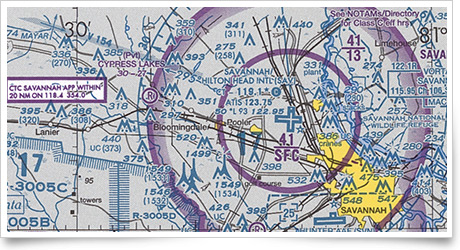Custom content for the Nov. 30, 2012, issue of 'AOPA ePilot' newsletter
| The following stories from the Nov. 30, 2012, edition of AOPA ePilot were provided to AOPA members who expressed an interest in the particular subject areas. Any AOPA member can receive information tailored to their areas of interest by updating their preferences online |
training tipsCommunicating with care
It’s a busy day on the frequency. With a 20-knot tailwind speeding you toward the destination, it would be prudent to establish communications for entry into the Class C airspace at the next opportunity in keeping with the Aeronautical Information Manual’s guidance: “Pilots of arriving aircraft should contact the Class C airspace ATC facility on the publicized frequency and give their position, altitude, radar beacon code, destination, and request Class C service. Radio contact should be initiated far enough from the Class C airspace boundary to preclude entering Class C airspace before two-way radio communications are established.”
What will you say when you report? You just passed the intersection of Interstate 16 and Route 67, about 27 nautical miles from the airport. What if there is no recognizable visual checkpoint available when you succeed in establishing contact?
You can state your distance and direction from the airport based on a GPS readout, or estimate it based on pilotage. Another way, if your aircraft is equipped with distance measuring equipment (DME), is to report your position as a radial and DME from the Savannah VOR.
Remember when reporting that you are inbound to the VOR; that is, you are flying the reciprocal course of the radial you are tracking. For example, if you are tracking a 110-degree course inbound with the VOR needle centered and a TO indication, you are inbound on the 290-degree radial. You would describe your position as, say, 25 miles from Savannah on the 290-degree radial, inbound.
Once approach control confirms radar contact, you will be given a transponder code to squawk and arrival instructions, such as the traffic pattern entry to expect for the runway in use. When you get closer, expect a handoff to the control tower.
Tomorrow, when you fly in your local practice area to work on maneuvers, don’t slack off the careful communications. If remaining within 10 miles of the nontowered airport, at altitudes used for arrivals and departures, monitor the airport’s common traffic advisory frequency, and make sure the other local traffic knows where you are. training productsAircraftSpruce.com is selling the book Rod Machado’s Private Pilot Workbook, created as a study guide for the FAA’s Private Pilot Knowledge Exam. The book prepares students for the exam and helps them understand and absorb the knowledge necessary to fly safely. It comes in paper and e-book form.
Note: Products listed have not been evaluated by ePilot editors unless otherwise noted. AOPA assumes no responsibility for products or services listed or for claims or actions by manufacturers or vendors. final examQuestion: I have separate logbooks for engine, airframe, and propeller. Can you clarify which aircraft logbook is required to have the annual inspection endorsement?
Answer: The annual inspection should be logged in the airframe logbook. Advisory Circular 43-9C states in paragraph 10(d), “When an owner maintains a single record, the entry of the 100-hour or annual inspection is made in that record. If the owner maintains separate records for the airframe, powerplants, and propellers, the entry for the 100-hour inspection is entered in each, while the annual inspection is only required to be entered into the airframe record.”
Got a question for our technical services staff? Email [email protected] or call the Pilot Information Center, 800/872-2672. Don’t forget the online archive of “Final Exam” questions and answers, searchable by keyword or topic. |
 Inbound to Georgia’s Savannah/Hilton Head International Airport from the northwest, you have received the automated terminal information service broadcast, noted the runway in use, and are mindful of
Inbound to Georgia’s Savannah/Hilton Head International Airport from the northwest, you have received the automated terminal information service broadcast, noted the runway in use, and are mindful of 

